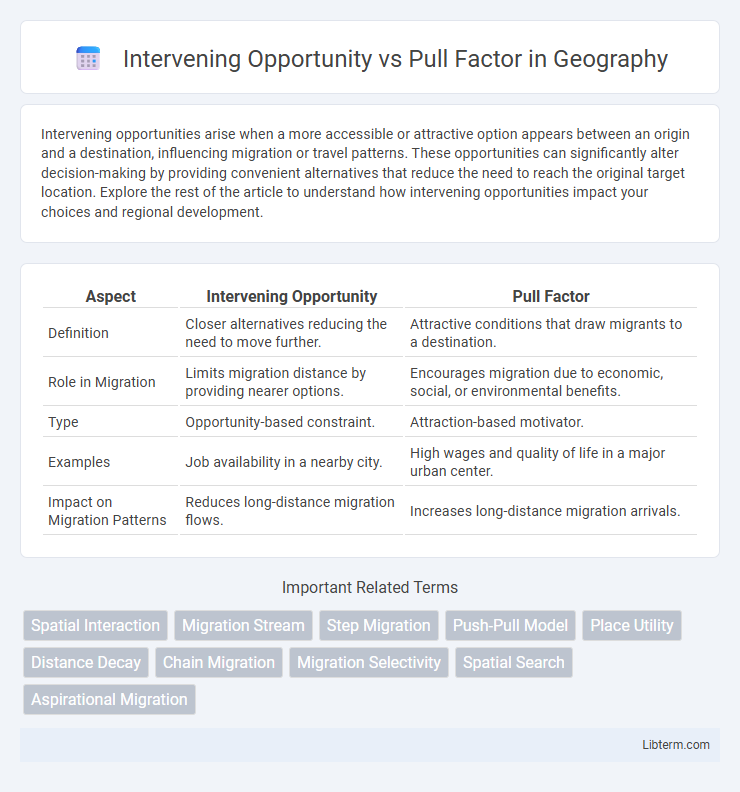Intervening opportunities arise when a more accessible or attractive option appears between an origin and a destination, influencing migration or travel patterns. These opportunities can significantly alter decision-making by providing convenient alternatives that reduce the need to reach the original target location. Explore the rest of the article to understand how intervening opportunities impact your choices and regional development.
Table of Comparison
| Aspect | Intervening Opportunity | Pull Factor |
|---|---|---|
| Definition | Closer alternatives reducing the need to move further. | Attractive conditions that draw migrants to a destination. |
| Role in Migration | Limits migration distance by providing nearer options. | Encourages migration due to economic, social, or environmental benefits. |
| Type | Opportunity-based constraint. | Attraction-based motivator. |
| Examples | Job availability in a nearby city. | High wages and quality of life in a major urban center. |
| Impact on Migration Patterns | Reduces long-distance migration flows. | Increases long-distance migration arrivals. |
Understanding Intervening Opportunity
Intervening opportunities refer to closer or more accessible alternatives that reduce the likelihood of individuals moving to a more distant destination despite strong pull factors there. These opportunities can include jobs, housing, or resources available en route, which make the nearer location more attractive and economically viable. Understanding intervening opportunities is crucial for analyzing migration patterns, as they explain why people often settle before reaching primary pull factor destinations like large cities or economic hubs.
Defining the Pull Factor
Pull factors are positive attributes or conditions in a destination that attract migrants, such as economic opportunities, better living standards, and political stability. These factors create incentives for individuals to move towards a specific location, contrasting with intervening opportunities that may offer closer or more accessible alternatives. Understanding pull factors is essential for analyzing migration patterns and the motivations behind human movement.
Key Differences Between Intervening Opportunity and Pull Factor
Intervening opportunities are geographic or economic factors that reduce the attractiveness of a more distant destination by providing a closer, more accessible option, while pull factors are attributes of a destination that attract migrants intentionally, such as better job prospects or favorable climate. The key difference lies in their influence on migration decisions: intervening opportunities act as obstacles or alternatives encountered en route, whereas pull factors serve as direct motivators drawing individuals to a specific location. Intervening opportunities often cause migrants to settle prematurely, whereas pull factors encourage movement toward the desired final destination.
Historical Context and Theoretical Background
Intervening opportunity theory, developed by E.G. Ravenstein in the late 19th century, posits that migrants are likely to settle at the first suitable opportunity encountered rather than continuing to a distant destination. Pull factor theory, rooted in Lee's migration model (1966), emphasizes specific positive attributes of a destination, such as economic prospects or social networks, that attract migrants. Historically, these theories reflect shifts in migration patterns, highlighting how immediate opportunities and destination appeal shape human mobility decisions.
Examples of Intervening Opportunities in Migration
Intervening opportunities in migration refer to favorable conditions or places that arise between an origin and a desired destination, influencing migrants to settle earlier than planned. Examples include job openings in a nearby city or affordable housing developments that attract migrants en route to larger urban centers. These opportunities often reduce the distance traveled and alter migration patterns by providing accessible alternatives to initial goals set by migrants.
Examples of Pull Factors in Migration
Pull factors in migration refer to the positive attributes that attract individuals to a new location, such as employment opportunities, better living conditions, and political stability. Examples include the booming tech industry in Silicon Valley attracting skilled workers worldwide, Canada's comprehensive healthcare system appealing to families, and Germany's strong economy drawing EU migrants seeking higher wages. Intervening opportunity contrasts with pull factors by emphasizing closer or more accessible alternatives that migrants may choose over distant destinations offering desired benefits.
Impact on Migration Patterns
Intervening opportunities alter migration patterns by providing closer or more accessible alternatives to migrants, reducing the likelihood of reaching original destinations. Pull factors, such as better job prospects or living conditions, attract migrants to specific locations, intensifying population flows toward those areas. The balance between intervening opportunities and pull factors shapes regional demographic shifts and influences urbanization trends worldwide.
Case Studies: Real-World Applications
Case studies reveal that intervening opportunities often divert migration flows by presenting closer or more accessible options, as seen in rural-to-urban migration patterns in India. Pull factors, such as economic incentives and better living conditions, strongly attract migrants, illustrated by the influx of skilled labor to metropolitan hubs like New York and London. Comparative analysis of these factors in case studies highlights their dynamic interplay in shaping regional migration trends and urban development.
Challenges in Differentiating the Two Concepts
Intervening opportunities and pull factors both influence migration decisions but present challenges in differentiation due to their overlapping impacts on migrant behavior. Intervening opportunities refer to nearer alternatives that decrease the likelihood of reaching the original destination, while pull factors include economic, social, or environmental attractions that draw migrants toward a specific place. Distinguishing between these concepts requires careful analysis of spatial scale, migrant motivations, and the timing of decision-making processes within migration models.
Policy Implications and Future Research Directions
Intervening opportunities and pull factors shape migration patterns, influencing policy frameworks that govern population movement and resource allocation. Policies must account for intervening opportunities, such as job availability en route, which may divert migrants and affect regional development strategies. Future research should explore the interplay between these factors using big data analytics to improve predictive migration models and inform adaptive policy measures.
Intervening Opportunity Infographic

 libterm.com
libterm.com